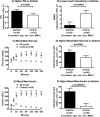Comprehensive Endocrine-Metabolic Evaluation of Patients With Alström Syndrome Compared With BMI-Matched Controls
- PMID: 29718281
- PMCID: PMC6276679
- DOI: 10.1210/jc.2018-00496
Comprehensive Endocrine-Metabolic Evaluation of Patients With Alström Syndrome Compared With BMI-Matched Controls
Abstract
Background: Alström syndrome (AS), a monogenic form of obesity, is caused by recessive mutations in the centrosome- and basal body-associated gene ALMS1. AS is characterized by retinal dystrophy, sensory hearing loss, cardiomyopathy, childhood obesity, and metabolic derangements.
Objective: We sought to characterize the endocrine and metabolic features of AS while accounting for obesity as a confounder by comparing patients with AS to body mass index (BMI)-matched controls.
Methods: We evaluated 38 patients with AS (age 2 to 38 years) who were matched with 76 controls (age 2 to 48 years) by age, sex, race, and BMI. Fasting biochemistries, mixed meal test (MMT), indirect calorimetry, dual-energy X-ray absorptiometry, and MRI/magnetic resonance spectroscopy were performed.
Results: Frequent abnormalities in AS included 76% obesity, 37% type 2 diabetes mellitus (T2DM), 29% hypothyroidism (one-third central, two-thirds primary), 3% central adrenal insufficiency, 57% adult hypogonadism (one-third central, two-thirds primary), and 25% female hyperandrogenism. Patients with AS and controls had similar BMI z scores, body fat, waist circumference, abdominal visceral fat, muscle fat, resting energy expenditure (adjusted for lean mass), free fatty acids, glucagon, prolactin, ACTH, and cortisol. Compared with controls, patients with AS were shorter and had lower IGF-1 concentrations (Ps ≤ 0.001). Patients with AS had significantly greater fasting and MMT insulin resistance indices, higher MMT glucose, insulin, and C-peptide values, higher HbA1c, and higher prevalence of T2DM (Ps < 0.001). Patients with AS had significantly higher triglycerides, lower high-density lipoprotein cholesterol, and a 10-fold greater prevalence of metabolic syndrome (Ps < 0.001). Patients with AS demonstrated significantly greater liver triglyceride accumulation and higher transaminases (P < 0.001).
Conclusion: Severe insulin resistance and T2DM are the hallmarks of AS. However, patients with AS may present with multiple other endocrinopathies affecting growth and development.
Trial registration: ClinicalTrials.gov NCT00068224 NCT00001195 NCT00001522 NCT00001723 NCT00005669 NCT00006073 NCT00030238 NCT00320177 NCT00758108 NCT01517048.
Figures



References
-
- Marshall JD, Paisey RB, Carey C, Macdermott S. Alstrom syndrome In: Pagon RA, Adam MP, Ardinger HH, Wallace SE, Amemiya A, Bean LJH, Bird TD, Ledbetter N, Mefford HC, Smith RJH, Stephens K, eds. GeneReviews(R). Seattle, WA: University of Washington; 1993–2018. Available at: www.ncbi.nlm.nih.gov/books/NBK1267/. Accessed 15 January 2018.
-
- Collin GB, Marshall JD, Ikeda A, So WV, Russell-Eggitt I, Maffei P, Beck S, Boerkoel CF, Sicolo N, Martin M, Nishina PM, Naggert JK. Mutations in ALMS1 cause obesity, type 2 diabetes and neurosensory degeneration in Alström syndrome. Nat Genet. 2002;31(1):74–78. - PubMed
-
- Hearn T, Renforth GL, Spalluto C, Hanley NA, Piper K, Brickwood S, White C, Connolly V, Taylor JF, Russell-Eggitt I, Bonneau D, Walker M, Wilson DI. Mutation of ALMS1, a large gene with a tandem repeat encoding 47 amino acids, causes Alström syndrome. Nat Genet. 2002;31(1):79–83. - PubMed
Publication types
MeSH terms
Associated data
Grants and funding
LinkOut - more resources
Full Text Sources
Other Literature Sources
Medical
Research Materials
Miscellaneous

